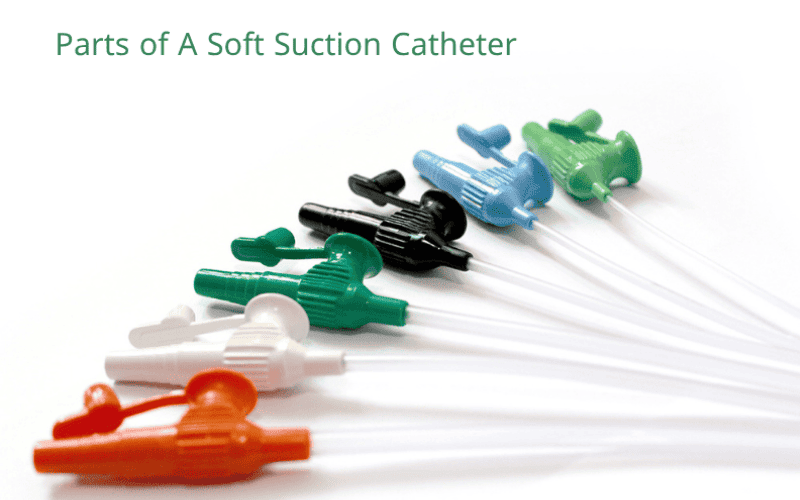TEl: +86-13148388090
Fax:+86-571-88616515
Parts of A Soft Suction Catheter
Author: admin / 2025-09-26For clinicians or medics, time is money. A soft suction catheter often meets their demands. But every part of this simple-looking tube is carefully made to ensure safety and performance. Knowing how the pieces work helps hospitals, pharmacies, and military teams choose better devices and avoid problems during airway care.

Clear Transparent Tube
The main body of the soft suction catheter is a transparent PVC tube. That clarity isn't just cosmetic—it lets clinicians see secretions as they're suctioned out in real time.
In the ICU, nurses often rely on that visibility to monitor whether they're pulling out thin mucus, thick plugs, or blood-tinged fluid. Each tells a different story about the patient's condition. Combat medics have similar needs: if they suction frothy pink fluid, that's a red flag for pulmonary injury. Without transparency, they'd be forced to guess and potentially miss critical signs.
Some models come frosted for better grip when gloves are sweaty or contaminated. However, transparency remains the gold standard when confirmation and decision-making matter most. In one study, respiratory therapists rated transparent tubing 25% higher for “diagnostic value” than frosted tubes during suction procedures.
Made of Non-Toxic Medical Grade PVC
The tubing is made of non-toxic medical-grade PVC—strong enough to withstand high negative pressure, yet flexible enough to pass smoothly through nasal or tracheal passages. High-quality catheters are DEHP-free, minimizing toxic exposure for neonates, oncology patients, and others with weakened systems.
Flexibility is key. The catheter must bend without collapsing. During training drills with cheaper brands, tubes with wall thickness under 0.8 mm were found to kink in up to 15% of trials, cutting suction flow. A kink at the wrong time can extend airway obstruction by precious seconds. Reliable PVC prevents collapse, giving clinicians confidence even under continuous suction.
The smooth inner surface of good PVC also reduces drag. That means secretions pass through without sticking and clogging, lowering the frequency of catheter changes—a detail that saves both time and cost in busy wards.
Lateral Eye Ensure Smooth and Safe Suction
At the distal tip, most catheters include one or two lateral eyes (small side holes). These aren't a minor design tweak—they prevent the tip from “vacuum-locking” against tissue. If the tip presses onto the tracheal wall, suction still flows through the lateral eye.
This feature is particularly critical in pediatrics, where delicate mucosa can be easily traumatized. Smaller lateral eyes distribute suction force more evenly, reducing the chance of tissue injury. Field medics value multiple eyes for a different reason: they keep suction effective even if the main tip clogs with clotted blood or debris.
Case in point: during a mass-casualty training, medics using single-tip catheters experienced a 20% higher rate of suction interruption compared to those using double-eye designs. That extra redundancy makes a big difference under pressure.
Color Coding Helps Fast Size Identification
Every suction catheter comes in different French sizes, and color coding at the connector hub provides instant identification. This is not just marketing—it's a frontline safety tool.
In an emergency, a respiratory therapist or nurse can grab a size 14 Fr in seconds just by spotting the orange connector. That quick match reduces errors and speeds up response. In neonatal ICUs, picking the wrong size can cause trauma or inadequate suction. In trauma bays, delays of even 30 seconds while checking labels can matter.
Military medics often highlight this feature in after-action reviews: in dim light, they may not be able to read tiny size markings, but they can still recognize color-coded hubs by touch and faint visibility. This design standard was adopted globally after studies showed color coding reduced size-selection errors by up to 40%.
Secure Funnel Connector
At the proximal end, the wide funnel connector anchors the catheter to suction tubing. This connection has to be airtight—any leak reduces negative pressure and lowers suction efficiency.
A poorly fitting connector can reduce suction by 10–15%, which translates into longer procedure time. In hospital trials, loose connections extended average suction duration from 12 seconds to nearly 20 seconds per pass. Multiply that across dozens of patients, and it's a serious efficiency drain.
In field settings, the funnel design makes a difference in speed: medics can connect and disconnect quickly while moving between casualties. Unlike slip-fit designs, the funnel is less likely to disconnect accidentally when equipment gets tugged or jostled. That stability is why many emergency kits specify funnel connectors over alternative designs.
Why These Parts Work Together
Each piece—tube, PVC material, lateral eyes, color code, funnel connector—works as a system. A transparent tube without a safe tip is risky. A good tip without a tight connector won't hold suction.
That's why buyers at hospitals and pharmacies look at these details before placing orders. And for medics in high-stress environments, those design choices are the reason the device works when seconds count.
Conclusion
Getting to know the structure of a soft suction catheter enables buyers and clinicians to use it correctly. BEVER Medical each design choice improves safety, speed, and patient comfort.
If your organization needs an FDA- and CE-certified Suction Catheter, BEVER Medical delivers OEM-ready solutions trusted by hospitals, pharmacies, and field medics worldwide. Contact us today and secure a reliable supply for your team.


